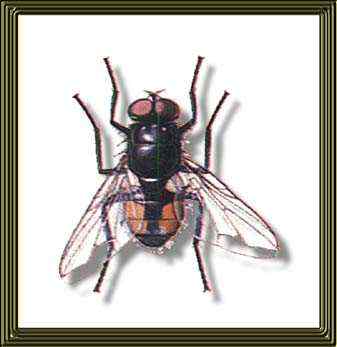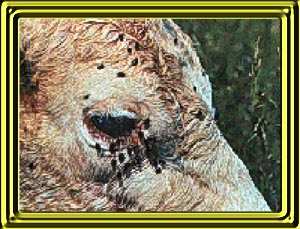
(Autumn or Face Fly)

This fly is very similar to the housefly, especially the female, but her eyes are closer together and her body is more rounded than in M.domestica. The male has more orange on his abdomen. This is the fly that you see swarming around cattle driving them mad, see above: This is also a fly which likes to sunbathe on walls and fences. These flies also enter houses and other buildings in autumn, just as the housefly population is declining, and hibernate for the winter.
Face flies are most likely to invade farm homes or homes located near pastures or where cattle are kept since the eggs are laid in cow pats and the larvae develop there also. During the summer, the adults feed on the mucous secretions from the eyes and noses of cattle and horses, see biology below:Description: similar to the closely related house fly, ca. 1/4 to 5/16 inch long and with a slightly darker body; sponging mouth-parts with microscopic rasping "teeth"; face between eyes and mouth is silvery.
Domestic animals affected: horses and cattle.
Damage caused: nuisance effect on animals, but research shows no direct reduction in performance; they mechanically vector Moraxella bovis (pinkeye) bacteria and are biological vectors of nematode eyeworms that affect cattle and horses.
Development: complete metamorphosis: egg, three larval instars (maggots), pupa, adult; puparium is white, calcified.
Generational time: usually 12 to 20 days depending on temperature.
Oviposition site: fresh cow manure within hours after deposition.
Larval habitat, feeding: larvae live in cow dung pats, feeding on the microbial flora and fauna in it and on decomposition products resulting from microbial activity.
Adult habitat, feeding: Off the host, they rest on vegetation or structures at night and most of daylight hours or feed on plant sugars and juices on the surface of manure deposits. On host animals, they obtain protein from nasal mucus, saliva, and tears; microscopic "teeth" on their tongues are used to abrade eye tissue to stimulate the flow of tears (see Note below). Opportunistically, they are attracted to, and feed on, blood made available by horse fly bites or other wounds. Face flies do not enter dimly-lighted building interiors.
Method of dispersal or infestation: Strong fliers capable of traveling several miles, but most stay within the host’s vicinity; they do not come into buildings except for the autumn (diapausing) brood which seeks an overwintering site.
Seasonality: Adults emerge from winter hibernacula in March and early April and may be temporarily abundant on faces of cattle and horses at that time; then they decline in number until June or July when the population rebounds; present to numerous into mid-October.
Notes or comments: 70 to 95% of face flies on an animal are females, as they need more protein than do the males.